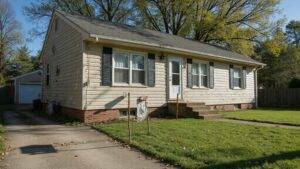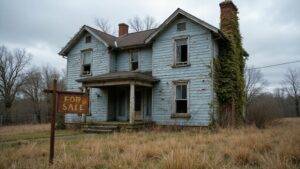Selling a hoarder house comes with big challenges. You must decide if you should renovate or sell the property as-is. Each option has risks and rewards, and the wrong choice can cost you time and money.
These houses often need major cleaning and repairs. Renovations can get expensive fast and may not always bring a higher selling price. Selling as-is can mean a lower offer, but avoids stress and big expenses.
For most owners, selling a hoarder house as-is is the smartest solution. It is usually faster and avoids high upfront costs. This option helps you move on quickly. This blog will guide you through the decision and show how to make the best choice for your situation.
Key Takeaways
- Renovating a hoarder house improves buyer appeal and increases the likelihood of a faster, higher-priced sale.
- Renovations help address hidden hazards like mold, pests, and structural damage, reducing buyer concerns and legal risks.
- Cleaning and updating the property can lead to better appraisals and higher market valuations.
- Weigh renovation costs against potential resale value to ensure it’s financially worthwhile before selling.
- Disclosing repairs and improvements is required in Virginia and can protect you from legal issues after closing.
Understanding the Challenges of Hoarder Houses

Hoarder houses have many problems that are not found in regular homes. These places often have mold, pests, and damaged walls or floors. Cleaning and fixing these issues usually costs more money and takes more time.
Owners or their families may be very attached to the things inside. If this happens, removing items from the house can take longer. Renovations may be delayed if people are not ready to let go.
Buyers may avoid hoarder houses because of these problems. If you plan to sell, expect a lower price and a longer wait. You should prepare for extra time, money, and care when dealing with a hoarder house.
Be aware that legal and liability considerations can add further complications, as sellers in Virginia must disclose property conditions and address health risks, which makes selling these homes even more challenging.
Assessing the Severity of the Hoarding Situation
You’ll need to identify the level of hoarding to understand the scope of work and potential costs. Check for structural damage, as hidden issues can impact both renovation expenses and market value. Don’t overlook health and safety risks, since these factors directly affect buyer interest and legal compliance.
When evaluating a hoarder house, it’s also essential to consider how property condition can significantly affect the speed and success of your sale. Be mindful that disclosure requirements may come into play, especially in situations where hoarding has caused visible damage or ongoing health hazards.
Identifying Hoarding Levels
Accurately identifying hoarding levels is important before starting any renovation or putting the house on the market. Hoarding severity affects your renovation plan and budget choices. If you know the level, you can make better decisions.
Mild hoarding may need only basic cleaning and new storage solutions. These small changes help attract buyers without much cost. Moderate or severe cases need professional cleaning and bigger repairs.
You should check every room for clutter, blocked exits, and pest signs. An honest record helps you set priorities and budget your resources. If you assess the level correctly, your renovation work will meet buyer expectations and raise the home’s value.
Evaluating Structural Damage
Structural damage is a major risk in homes affected by hoarding. You should check for this early in the renovation process. Damage can increase costs and affect the home’s value.
Start by looking for signs like sagging floors, bowed walls, or ceiling cracks. Hoarded items can trap moisture, which leads to wood rot or mold. If you see these problems, there may be hidden damage.
Inspect the basement and crawl space for water or signs of a shifting foundation. These issues can make repairs much more expensive. Document everything so you can estimate costs and make informed decisions.
If you are unsure, a licensed structural engineer can help. An expert’s opinion can prevent costly mistakes. This will help you decide if the renovation is worth the investment.
Health and Safety Risks
Health and safety risks in a hoarder house can be serious. Mold, pests, and biohazards can harm anyone in the home. If you plan to renovate or sell, check for these dangers first.
Blocked exits, loose piles, or animal waste can be immediate threats. Property owners should remove these risks before any work starts. If you find severe hazards, call professionals for cleanup.
Proper safety gear like gloves, masks, and protective clothing is important. Workers and visitors should always use this equipment. Skipping these steps can lower property value and delay a sale.
Legal and Safety Considerations
Before you start renovations, make sure the property meets local code compliance requirements to avoid costly delays or fines. It’s crucial to arrange a professional health hazard assessment, since hoarder homes often hide risks like mold or biohazards. Addressing these issues upfront protects your investment and ensures a smoother sale process.
Many cosmetic flaws, such as surface scratches or stains, can often be left as-is when selling and do not require repairs. In Virginia, legal disclosure requirements demand that sellers be transparent about known hazards or defects, making upfront assessments even more important.
Code Compliance Requirements
A hoarder house must meet all local code compliance rules before you sell. These rules help prevent legal trouble and keep the home safe. If you ignore them, you could face delays or extra costs.
Zoning laws decide what you can do with the property. Any changes or fixes must follow these rules. If not, you might not be able to sell as planned.
All repairs, electrical work, and plumbing must meet city codes. If you skip permits, you could face fines or be forced to undo work. Unapproved changes can also raise your property taxes.
If you fix code problems early, you make your home safer and easier to sell. This also protects you from legal issues. Buyers will feel more confident about the property.
Health Hazard Assessments
A health hazard assessment checks for hidden dangers in hoarder houses, such as mold, pests, or biohazards. This assessment is necessary before selling the property. It helps you understand all visible and hidden damage.
Buyers and their agents often want proof the house is safe. If you skip this step, insurance may not cover health issues or hidden damage. You could also face legal problems.
A professional assessment can support a higher price and better negotiation. If local laws require it, you must comply to avoid fines. Prioritizing this step protects your investment and makes the sale smoother.
Evaluating the Costs of Renovation

Evaluating the costs of renovation is necessary before starting work on a hoarder house. Accurate cost estimates help you decide if the project is worth it. Compare the home’s current state with similar properties to set a realistic budget.
Assess all needed work, including cleanup and repairs. If there are hidden problems, expect extra costs. Always check for required permits and the cost of professional help. If water damage or mold is discovered during evaluation, it’s important to consider how these structural and health risks could increase total renovation expenses.
Group expenses into categories for better planning. Main costs include junk removal, repairs, and cosmetic changes. Create a backup fund for surprises during the renovation.
Careful cost evaluation helps you avoid spending too much. If you plan well, you can protect your potential profit. Alternatively, selling the home to a cash home buyer that purchases properties as-is can help you avoid renovation expenses and the hassle of repairs.
Potential Return on Investment
A hoarder house renovation can offer a good return on investment if you know your local market. Cleaning and renovation costs must be balanced against the possible resale price. Buyers pay more for homes with updated kitchens, bathrooms, and curb appeal.
If the neighborhood has high home values, strategic updates can help you make a profit. You should keep your budget realistic to avoid overspending. Over-improving a house can reduce your overall return. If the property has any title issues or liens that affect ownership clarity, resolving them before listing it for sale can help you avoid transaction delays and maximize your selling price.
Initial cleaning costs in a hoarder house are often high. These costs will affect how much you can spend on other renovations. If you track all expenses and compare recent sales, you can better estimate your profit. It’s also important to be aware of disclosure requirements for any pest or structural issues discovered during renovation, as failing to inform buyers can lead to legal and financial complications.
The Impact on Market Value

When you renovate a hoarder house, you boost its appeal to buyers, which can directly influence how appraisers and agents price the property. A cleaner, updated space often leads to a higher valuation and broadens your pool of interested buyers. This increased demand can significantly improve your return on investment when you sell.
Compared to selling as-is, renovations can help you avoid a lower sale price and attract more traditional buyers instead of limiting yourself to just investors or flippers. In Virginia, making even simple improvements—such as enhancing curb appeal or adding a fresh coat of paint—can be especially effective in drawing in serious buyers and speeding up the sales process.
Increased Buyer Appeal
Transforming a hoarder house into a clean space makes it much more attractive to buyers. A tidy, organized home is easier to sell. Buyers are more likely to make offers on homes they can imagine living in.
If you remove clutter and add storage, key areas of the house stand out. Updated kitchens and bathrooms become easier to notice during showings. Clean spaces also help buyers feel confident about the home’s condition.
Potential buyers may worry less about hidden issues if the property looks well-kept. If you invest in smart renovations, you can often get higher offers. A well-presented house can overcome the negative image of a hoarder home.
Appraisal and Pricing Effects
Boosting buyer interest can increase your home’s appraised value and final selling price. A clean, updated home lets the appraiser see its real features. This can help prevent a low appraisal that hurts your selling price.
Removing clutter and fixing damage improves appraisal accuracy. If your home looks well-maintained, you can set a higher asking price. This also gives you more options for pricing strategies.
Appraisers, buyers, and lenders need to see the true condition of your home. If you present your home well, you can expect a better result when selling. In today’s market, this step is essential for a successful sale.
Return on Investment
Renovating a hoarder house can increase your return on investment. If you spend wisely, upgrades can raise your property’s value. You should compare renovation costs to the price you hope to get.
Buyers may see hoarder houses as risky. Visible improvements can change this view and attract better offers. If you focus on key repairs, you can make your house more appealing.
Curb appeal can make the home look inviting. Fixing structural issues may reassure buyers about the home’s stability. Modern kitchens and bathrooms often boost buyer interest.
If you address health and safety issues, you could reduce buyer concerns. Move-in-ready homes typically attract more buyers. Smart renovations may lead to higher sale prices and faster closings.
Attracting Traditional Homebuyers vs. Investors

You should choose your renovation style based on your area’s main buyers. If most buyers are families or first-time homeowners, use simple designs. Open layouts and modern finishes work best for this group.
Luxury features like quartz counters or smart devices can boost your home’s value. These upgrades help attract traditional buyers and raise your asking price. They also make your home memorable. In some markets, selling directly to cash home buyers allows you to bypass extensive renovations altogether.
If your area has many real estate investors, focus on basic repairs and function. Investors want properties that need little extra spending. Over-upgrading may not give you a good return.
Always check local sales trends before making decisions. Compare similar homes and see what sells fastest. This research ensures your renovation matches buyer demand. Before listing, make sure to declutter and depersonalize living spaces to create a more inviting and neutral environment for potential buyers.
Timeline for Renovation and Sale
A clear timeline helps you renovate and sell your property efficiently. It ensures you stay on schedule and avoid unnecessary delays. Careful planning can also help you get the best price for your home. For sellers hoping to avoid hassle or long wait times, flexible closing timelines offered by certain buyers in Broadway can help streamline the sale process.
First, assess the property’s condition to know what repairs are needed. Next, secure financing for the renovation if you need it. Delays in funding can push your schedule back.
Renovation work should be scheduled and completed as planned. After renovations, clean and stage the home for potential buyers. Listing and marketing the property is the final step before the sale.
Remember, organizing all paperwork and escrow details in advance can help avoid delays once you’re ready to close the sale.
Working With Professional Cleaners and Contractors

Working with professional cleaners and contractors is important when preparing a hoarder home for sale. These experts can help make the house more appealing and valuable to buyers. If you want to sell quickly, hiring professionals is a smart choice.
Professional cleaners remove deep dirt, tough odors, and hidden stains. Their work helps the home look and smell fresh, which attracts more buyers. They use special tools and methods that most homeowners do not have.
Contractors check the house for damage and suggest repairs that fit your budget. They can update old rooms and recommend better storage solutions. If you want the home to stand out, their advice is useful.
Hiring specialists can prevent costly errors and save you time. If you follow local building codes, you will avoid legal problems. In the end, using experts may help you sell for a higher price.
Emotional and Psychological Factors
As you tackle a hoarder house renovation, expect significant emotional hurdles, including stress from decluttering and strong attachment to possessions. You’ll likely face tough decisions about what to keep or discard, which can slow progress and impact your timeline. Recognizing these challenges early helps you plan realistic schedules and maintain momentum toward a profitable sale.
Stress of Decluttering
Decluttering a hoarder house is mentally and emotionally stressful. The process often causes anxiety and decision fatigue. Sorting so many items is a big challenge.
Professional cleaners or organizers can make the job easier if needed. Hiring a junk removal service helps speed up progress. These experts handle large volumes efficiently.
Sorting and categorizing items takes time and focus. Emotional fatigue may occur before you feel physically tired. Setting realistic daily goals prevents burnout.
A clear plan helps reduce stress. If you stay organized, the house becomes more market-ready. Careful preparation makes the task more manageable.
Attachment to Possessions
Emotional attachment to possessions makes cleaning out a hoarder house difficult. Many owners see value in items that seem ordinary to others. This emotional bond creates challenges during renovation and slows progress.
If owners have strong sentimental ties, decluttering will take longer. Fear of losing meaningful items may increase resistance to change. Family heirlooms often need extra care and respect.
Perceived security from belongings can make removing items harder. Clear communication and patience can help ease the process. If you handle possessions thoughtfully, you can better prepare the property for sale.
Decision-Making Challenges
Decision-making is often hard during a hoarder house renovation. Psychological barriers can slow down your progress and affect your plans. These issues may also impact your budget and legal requirements.
You might fear making permanent mistakes with belongings. Some people worry about renovation costs or changes in property taxes. Others may feel unsure about following local zoning laws.
The amount of work can feel overwhelming at first. If you struggle to see the property’s potential, it may be hard to make decisions. Recognizing these problems early can help you find solutions.
Disclosure Requirements for Sellers
To ensure a smooth sale of a hoarder house, you must be honest about the property’s condition. Sellers are legally required to disclose all major issues. This includes any problems that could affect value or safety.
Common issues in hoarder homes are structural damage, bad smells, pests, and mold. If you have cleaned or staged the house, mention those steps to buyers. Buyers want honesty, and sharing these details builds trust.
If you hide defects, you could face legal trouble later. Always check with a real estate agent or lawyer about what to disclose. Proper disclosure can help your sale go faster and protect you after closing.
Alternatives to Full Renovation
If you cannot do a full renovation, there are still ways to make a hoarder house ready for sale. These options cost less money and take less time than a full remodel.
Start with a deep cleaning. Remove all clutter and personal items. Clean the floors, walls, and windows to make the home look fresher.
If you have a small budget, try simple updates. You can paint walls in neutral colors and replace old fixtures. New hardware on cabinets and doors also helps.
Home staging can help buyers see the home’s best features. Professional staging makes rooms feel larger and more inviting. If you cannot stage, use simple furniture and keep spaces open.
These steps help your home attract buyers. They also can improve your sale price without needing big renovations.
Selling As-Is: What to Expect
Selling a home “as-is” means you will not make repairs or updates before selling. Buyers must accept the property in its current condition. This approach is common for hoarder houses.
Most buyers will be investors or cash buyers who expect to clean and fix the home themselves. Offers will likely be lower because buyers include cleanup costs in their price. Traditional buyers looking for a move-in-ready home will usually not be interested.
You must fully disclose the condition of the property to buyers. If you sell “as-is,” you can avoid the stress and cost of major renovations. Faster sales and fewer obligations might make up for the lower sale price.
Marketing should highlight the home’s potential rather than its present state. If you are clear about the condition, the sale process will be smoother. Selling “as-is” may not yield the highest price, but it is often the simplest option.
Tips for Making the Best Decision
To make the best decision, first look at your goals and the money involved. Check the condition of the house and the local market. Decide what matters more: getting more money or selling quickly. Start by weighing your goals, finances, home condition, and market trends to decide if speed or profit matters most.
If you want a higher price, you may need to fix and clean the house. Renovating and staging attract more buyers but cost money and time. Selling as-is is faster but usually brings lower offers.
Analyze what similar homes sold for in your area. Compare possible renovation costs with the profit you might make. If repairs take too long, selling as-is may be better.
Decide if your buyer is likely an investor or someone who wants to live there. Choose marketing steps that match your target buyer. If you feel unsure, talk to a real estate agent for advice.
Conclusion
If you are deciding whether to renovate a hoarder house before selling, you should carefully consider your options. If the repairs are small, basic updates could help you attract more buyers and increase your selling price. However, if the house needs significant repairs, selling as-is may make more sense.
If you choose to sell as-is, you could save time and avoid stress. Many investors and companies buy houses for cash, even in challenging conditions. This option can provide you with a quick and straightforward sale.
If you want a fast and hassle-free sale, we can help. At Align Real Estate Solutions, we buy houses for cash in any condition. Contact us today to see how we can make selling your hoarder house easy.
Author
-

Zach Koops is co-founder and Real Estate Success Manager at Align Real Estate Solutions, serving homeowners across Virginia since 2024. With a passion for real estate and a heart for people, Zach has built his career around helping sellers navigate tough situations—foreclosure, inheritance, relocation, repair-overload—with clarity and compassion. He’s known for being straightforward, steady under pressure, and deeply invested in relationships. Outside of work, he spends his time as a husband and father, enjoys the outdoors in Shenandoah Valley, loves singing on stage, and constantly seeks growth through reading and new experiences.









